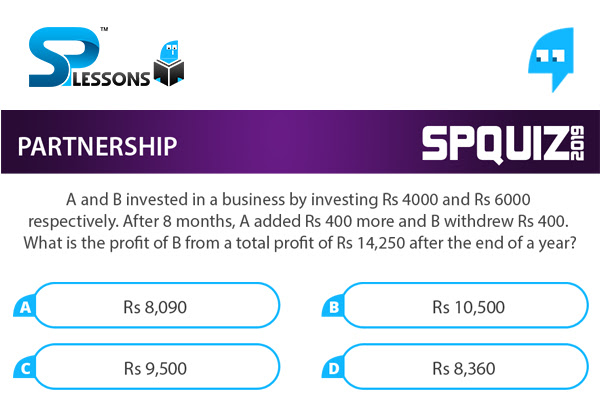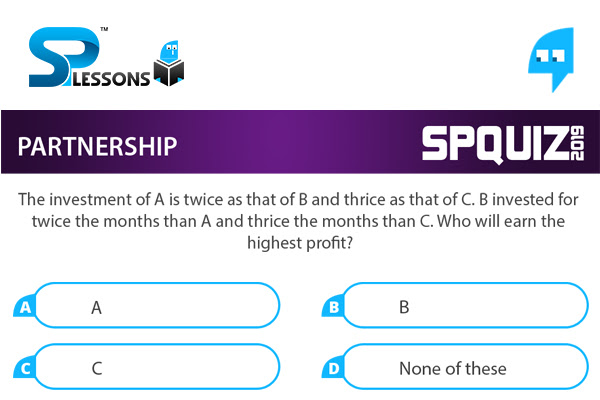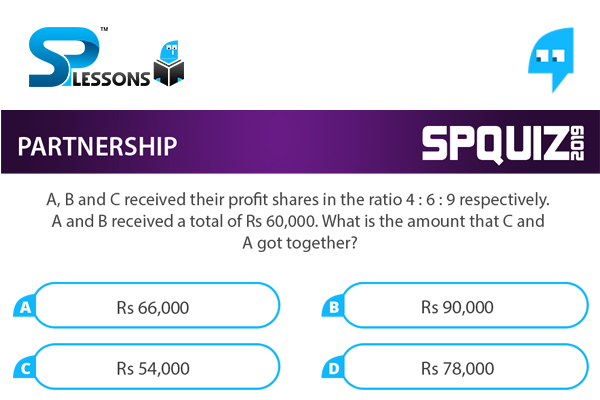 Introduction
Introduction
Partnership Quiz 2 chapter deals with profit and loss related problems. Profit and/or loss is shared among the partners based on the sum of money invested by individual partners and the time period of the investment.
For example: A partner who has invested the highest amount of money/resources will receive the highest share of the profit at the end of the year provided all the partners have invested for the same time period.
Ratio of Division of Gains:
1. Suppose A and B invest Rs. [latex]x[/latex] and Rs. [latex]y[/latex] respectively for a year in a business, then at the end of the year:
(A's share of profit) : (B's share of profit) = [latex]x[/latex] : [latex]y[/latex]
Here investment of all partners are for same time, and the gain or loss is distributed among them in the ratios of their investments.
2. Suppose A invests Rs. [latex]x[/latex] for 'p' months and B invests Rs. [latex]y[/latex] for 'q' months, then
(A's share of profit) : (B's share of profit) = [latex]x[/latex]p : [latex]x[/latex]q
Here investments are for different time periods, equivalent capitals are calculated for a unit of time by taking,
(capital x number of units of time).
Profit or loss is divided in the ratio of these capitals.
Working partner: The partner one who works for the business is called a working partner.
Sleeping partner: The partner who simply invests the money for the business and doesn't work is called a sleeping partner.
Concept 1: If a group of n persons invested different amount for different period then their profit is the ratio is [latex]At_{1}[/latex] : [latex]Bt_{2} [/latex] : [latex]Ct_{3} [/latex] : [latex]Ct_{3} [/latex] : [latex]Dt_{4} [/latex] : …… : [latex]Xt_{n} [/latex]
Here first person invested amount A for [latex]t_{1} [/latex] period, second persons invested amount B for [latex]t_{2} [/latex] period and so on.  Q1
Q1
A and B invested in a business by investing Rs 4000 and Rs 6000 respectively. After 8 months, A added Rs 400 more and B withdrew Rs 400. What is the profit of B from a total profit of Rs 14,250 after the end of a year?
- A. Rs 8,090
B. Rs 10,500
C. Rs 9,500
D. Rs 8,360
A : B
[latex] 4000 \times 8 + 4400 \times 4 : 6000 \times 8 + 5600 \times 4[/latex]
31 : 44
So B gets = [latex](\frac{44}{75}) \times 14,250[/latex] = Rs 8,360
 Q2
Q2
The investment of A is twice as that of B and thrice as that of C. B invested for twice the months than A and thrice the months than C. Who will earn the highest profit?
- A. A
B. B
C. C
D. None of these
If A invested Rs x, then B Rs [latex](\frac {x}{2})[/latex] and C invests Rs [latex](\frac {x}{3}).[/latex]
Let B invested for y months, then A for [latex](\frac {y}{2})[/latex] months, and C for [latex](\frac {y}{3})[/latex] months
So ratio of profit shares-
A : B : C
[latex]x \times (\frac {y}{2}) : (\frac {x}{2}) \times (y) : (\frac {x}{3}) \times (\frac {y}{3})[/latex]
[latex]\frac{1}{2} : \frac{1}{2} : \frac{1}{9} = 9 : 9 : 2[/latex]
Both A and B gets equal and highest profits.
 Q3
Q3
Out of the total investment, A invested [latex]\frac {1}{4}[/latex]th, B invested [latex]\frac {1}{3}[/latex]rd of the remaining and C the remaining. B earned Rs 10,000 after a year. Find the yearly profit of all.
- A. Rs 45,000
B. Rs 40,000
C. Rs 58,500
D. Rs 49,600
Let total investment = Rs x
Then A’s = [latex](\frac{1}{4}) \times x[/latex]
Remaining = [latex]{(\frac {3}{4})}^{th} [/latex] of x
So B’s investment = [latex](\frac {1}{3}) \times (\frac {3x}{4}) = \frac {x}{4} [/latex]
And C’s = x – [latex](\frac {x}{4} +\frac {x}{4}) = \frac {x}{2}[/latex]
so ratio of profits = [latex]\frac {x}{4}: \frac {x}{4} : \frac {x}{2} = 1 : 1 : 2[/latex]
so [latex]\frac {1}{4} \times x = 10,000[/latex]
x = 40,000
 Q4
Q4
Out of a total profit of Rs 19,600, B received Rs 10,000 as his share. If A invested Rs 8,000 for 6 months while B invested his amount for 5 months, then what is the amount invested by B?
- A. Rs 6,000
B. Rs 8,500
C. Rs 8,500
D. Rs 10,000
Profits ratio = [latex]8000 \times 6 : x*5 = 9600 : x[/latex]
So
[latex][\frac {x}{(9600 + x)}] \times 19,600 = 10,000[/latex]
Solve, x = 10,000
 Q5
Q5
A, B and C received their profit shares in the ratio 4 : 6 : 9 respectively. A and B received a total of Rs 60,000. What is the amount that C and A got together?
- A. Rs 66,000
B. Rs 90,000
C. Rs 54,000
D. Rs 78,000
Their shares are 4x, 6x, 9x resp.
4x + 6x = 60,000
x = 6,000
So C got 9 × 6000 = 54,000 and A got 4 × 6000 = 24000
So total = 78,000








